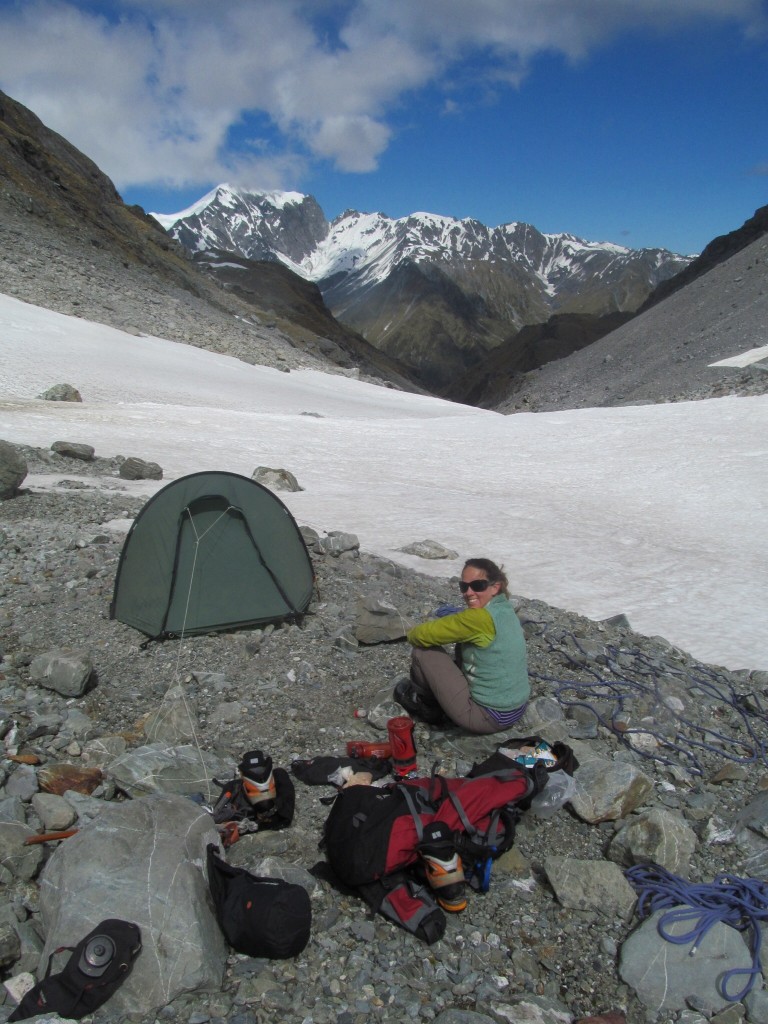“Huh, you all did it in two days, eh?” Barbara asked us. “You got to Hari Hari yesterday and then hiked in?” she further queried for clarification.
“No, we took two days to hike in” I respond, slightly embarrassed. “We walked in past the cable bridge at Hendes Creek, camped and then travelled the rest of the way today. It was pretty wet and we are headed in for ten days…” I trail off.
“Hmm” then a protracted silence is her trying to be non-judgmental reply. “Well it seems like you have a lot of gear huh?”
“Yeah, our packs are heavy.”
Amy and I are tucked into bunks at the small, clean and functional Hunter’s Hut several kilometers up the Wanganui River on New Zealand’s wet and steep west coast. We had gotten to the hut around mid-afternoon after a nine o’clock start. We lay down in the green grass, spread our damp clothing and gear in the sunshine, and soaked up the rest. The sign at the start of the track proclaimed “Hunter’s Hut – 5 Hours”. Our bodies said two days or twelve and a half hours of on track time. Barbara and her posse of folks from Hokitika arrived at the hut around 7 or so, just as Amy and I were settling into sleep. They were gunning for a day hike up to Blue Lookout the following day and were quite fresh. They had left the parking lot at ten.
The idea of Latin Time is quite well known. It is the concept of people who have laid back attitudes and a “why rush” approach to life and how in social settings, timeliness is not that important. There are theories revolving around Mediterranean origins and not adopting the pace of life of the mass of the United States or how the Spanish language’s verb structure causes an attitude of living in the present. Whatever the origin, it is somewhat expected in Latino social culture. Kiwi’s too, tend to have a pretty laid back and easy going attitude about life, so one would surmise that Kiwi Time and Latin Time are synonymous. This is not the case however. Kiwi Time is a means by which New Zealanders show their superiority.
Several weeks earlier, myself, a co-instructor and nine students were deposited at the start of the Kelly Creek Track on the edge of Arthur’s Pass National Park. We were shooting for a hut beyond the head waters of Kelly Creek. The students were in their last section of what had been a successful and fun semester and were leading the charge with planning days, routes, hiking groups, etc. The sign read “Carroll Hut – 3 Hours” & “Hunts Creek Hut – 5 Hours” [apostrophe NOT on sign]. The students, having just completed a 20+ day hiking section elsewhere in New Zealand’s mountains, set their sights on the the Hunt’s Creek Hut. Two days later, late in the afternoon, we staggered into an open meadow filled with head high snow grass surrounding the small, four bunk hut. The students were not excessively slow hikers, though the off track travel up the river bed was relatively new to them. As we dropped our packs in a small clearing some students thought to chuckle ironically at the five hour time listed on the Department of Conservation (DoC) track sign.

Back at Hunter’s Hut Amy and I glanced at the DoC sign pointing its way toward the Lambert Tops. The parking lot sign had read nine hours to the Lambert Tops. Now this sign was reading four, as it should, in relation to the time to Hunter’s Hut. We knew to take this with a grain of salt, given our experience on the island with DoC tracks and times. We also noted the time to the Adam’s River trail junction. Thirty minutes. We were only ten minutes off the possible time when we reached the Blue Lookout junction, as a sign said 15 minutes from there to the hut. Sixty-five minutes later, after crossing the Lambert River via a swing bridge and a fair amount of rocky river bank travel, we reached the trail junction to the the Tops. Three times as long. Seemed about average, par for the course, for the North Americans we were. From there it was an uphill battle to the tops. We pulled, pushed, grunted, sweated, and cursed our way upward through thick bush, branches, dead fall, and flax. We slipped, we slid, we huffed and puffed and sometime around two o’clock we bashed out of the big trees and into a small clearing. We rested once again, with the clouds, light breeze, and occasional rain drops providing relief from the internal furnace. The end of the track and the Lambert Tops still lay a couple kilometers and several hours above us. Though lower angle, the harder bushbashing and route finding was still to come. We wound our way along the ridge, keeping our weary eyes peeled for each orange triangle and other signs of human passage. A cut branch here, a foot print there, and a t-shirt in the flax all gave the forward clues we needed. Ten hours after leaving the hut we stumbled across a small puddle of water deep in the tussocks. We fell upon it and greedily filled our bellies and then our containers. A quick scout found a suitable campsite, flat, though not well protected, and we called it quits, erecting our shelter and cooking our repast. DoC’s nine hours to the Lambert Tops proved to be a hard three days jaunt for us. Seems about right.
Lucky for us terrain and our lack of physical superiority gave us the opportunity to give the stated times another run for their money. After a few days on the tops including a windblown attempt on summiting Mt Lamber via its northern flank, we turned tail and started back down the way we came. This time, in order to up our chances of success I took copious notes. Our gravity aided descent was not hindered by things such as driving winds and rains or uphills, so we had a bit of an advantage.
We hit the large pole at the top of the Lambert Tops track at twenty-five minutes past ten and took an hour to hike to the bottom of the scrub/treeline. Our knees hated us as we descended quickly the steep, unrelenting, and slippery track. Two hours and twenty minutes after leaving the treeline we reached the junction with the Adams River spur. We looked at the metal sign. The well constructed sign was green, had yellow writing and proclaimed three hours and thirty minutes to the Lambert Tops. We did the math. Three hours and twenty minutes! We had beat the DoC time. “Of course” Amy says, stating the obvious, “it was all down hill.” I also throw in that I did not calculate any our break time into the equation either. “And we took a lot of breaks” she adds. So it goes without saying, we surmised, that the people who figured out the times on the sign were dropped off by helicopter at the tops and measured their time on the descent. If they were dropped off by helicopter, we further deduced, they had no need for heavy packs, therefore, no need to rest as we did, for about twenty minutes after each hour of travel. That made sense. They probably just didn’t realize folks would be going UP with heavy packs. Fair enough. We looked at the sign. With an arrow pointing in our intended direction of travel it read “Hunter’s Hut—30 min.” “Hmpph” well, it seems we would have to best that, but If previous experience was any guide, we had about ninety more minutes to Hunter’s Hut. We turned and plodded on, arriving at the swing bridge thirty minutes later, still an hour from the hut. So much for momentum, I think.
Later at the hut, two trampers, Matt and Laura, come in from the Lambert Tops. Matt grew up in the states, Laura was a native Kiwi. “What is up with that sign?” Matt asks. “Thirty minutes to the hut from the junction and four hours from here to the tops? That is ridiculous.” Laura, the good Kiwi she is, says nothing, just laughs, as if to say “gotcha.” Amy and I commiserate with our fellow yankee, shaking our heads at the ludicrousness of it all. At least we weren’t the only ones I think to myself. After a supper from the Jetboil, we sit on our bunks and chat with Matt and Laura. I journal intermittently, do a little math and conclude several things. First, we hiked for a total of five hours and fifty minutes and took a total of one hour and forty six minutes worth of breaks for a total travel time of about seven and a half hours. Second, we take long breaks, on average twenty minutes for each hour traveled. Third, regardless of whether the time was measured hiking up or hiking down, or to Hunt’s Creek Hut or Hunter’s Hut, it is impressive. It truly makes me feel inadequate and makes me, not want to be stronger or fitter, but instead to just stay home. Or be a Kiwi. The bottom line however: Kiwis are superhuman, plain and simple.
